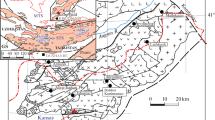Abstract
The Macassa Gold Mine is the only operational mine (Lac-Minerals Ltd., Macassa Division) of seven original gold producers in the Kirkland Lake camp of northern Ontario, Canada. The gold deposit is in Archaean volcanic and sedimentary rocks which have been intruded by a composite syenite stock. The mineralization has taken place in two stages. The first stage is not gold bearing but involves pyritization and concomitant development of titanium phase minerals (leucoxene, rutile) and hematite. It is mainly associated with carbonatization, silicification and hematitization marked by Ba, Sr and Rb enrichment. In contrast to this, the quartz vein-type mineralization is associated mainly with later silicification and enrichment with tellurium, lead, silver, gold and copper. It is relatively depleted in Sr, Ba and Rb. The ore mineralogical assemblages in the second stage include pyrite, chalcopyrite, petzite, altaite and native gold. Geochemical and petrographic evidence indicate that the reddened wall rocks (hematitized) and reddened fragments are neither related with nor contain any gold. Therefore, hematitization and the presence of barium, in this case in K-feldspars, could not be considered as the sole evidence to suggest a magmatic oxidizing fluid model for the genesis of Macassa gold deposit. Regarding the metals transport, tellurides and thiocomplexes are considered as the important carriers of gold and silver. Hence, fugacity of tellurium and sulphur controlled the precipitation of gold in the Macassa gold deposit.
Similar content being viewed by others
References
Afifi, A.M., Kelly, W.C., Essene, E.J. (1988) Phase relations among tellurides, sulfides, and oxides: Part-II: Application to telluride-bearing ore deposits. Econ. Geol. 83:395–404
Burrow, D.R., Spooner, E.T.C. (1986) The McIntyre Cu-Au deposit, Timmins, Ontario, Canada, p. 23–39. In: Macdonald, A.J. (ed.) Proceedings of gold 86: an International symposium on the geology of gold. Konsult International, Toronto, 517 p.
Cameron, E.M., Hattori, K. (1987) Archaean gold mineralization and oxidized hydrothermal fluids. Econ. Geol. 82:1177–1191
Dimroth, E., Imreh, L., Rocheleau, M., Goulet, N. (1983 b) Evolution of the southcentral part of the Archaean Abitibi belt, Quebec, Part III: Plutonic and Metamorphic evolution and geotectonic model. Can. I Earth Sciu. 19:1729–1758
Foster, R.P. (1986) Archaean gold metallogeny and exploration. Report No. 4 University of Southampton
Giordano, T.H., Barnes, H.L. (1979) Ore solutions geochemistry VI. PbS solubility in bisulfide solution to 300 °C. Econ. Geol. 74:1637–1646
Goldschmidt, V.M. (1937) The principles of distribution of chemical elements in minerals and rocks. J. Chem. Soc. (Lond) 655–673
Hinse, G.J., Hogg, G.M., Robertson, D.S. (1986) On the origin of Archaean vein-type gold deposits with reference to the Larder Lake ‘break’ of Ontario and Quebec. Mineral. Deposita 21:216–227
Hyde, R.S. (1980) Sedimentary fades in the Archaean Timiskammg Group and their Tectonic implication, Abitibi Greenstone Belt, Northeastern Ontario, Canada. Precamb. Res. 12:1961–1995
Kerrich, R., Fyfe, W.S. (1981) The gold-carbonate association: Source of CO2 fixation reaction in Archaean lode gold deposits. Chem. Geol. 33:265–294
Kerrich, R., Watson, G.P: (1984) The Macassa Mine Archaean Lode Gold Deposit, Kirkland Lake, Ontario: Geology, patterns of alteration, and hydrothermal regimes. Econ. Geol. 79:1104–1130
Ridler, R.H. (1970) Relationship of mineralization to volcanic stratigraphy in the Kirkland-Larder Lake area, Ontario. Geol. Assoc. Can. Proc. pp. 33–42
Seward, T.M. (1984) The transport and deposition of gold in hydrothermal systems. 165–181. In: Foster, R.P. (ed.) Gold 82: The geology, geochemistry and genesis of gold deposits. Balkeman, Rotterdam, 753 pp
Watson, G.P., Kerrich, R. (1983) Macassa Mine, Kirkland Lake. Production history, geology, gold ore types and hydrothermal regimes. In: Colvine, A.C. (ed.) The geology of gold in Ontario. Miscellaneous Paper 110
Author information
Authors and Affiliations
Rights and permissions
About this article
Cite this article
Tesfaye, G. Ore-microscopic and geochemical characteristics of gold-tellurides-sulfide mineralization in the Macassa Gold Mine, Abitibi Belt, Canada. Mineral. Deposita 27, 66–71 (1992). https://doi.org/10.1007/BF00196083
Received:
Accepted:
Issue Date:
DOI: https://doi.org/10.1007/BF00196083




